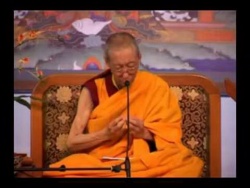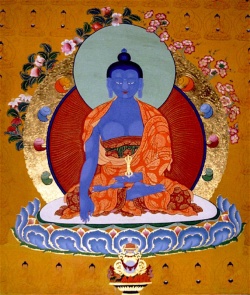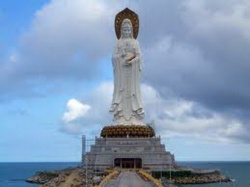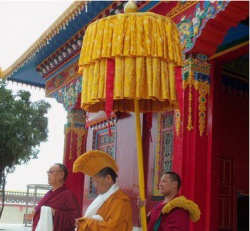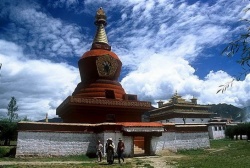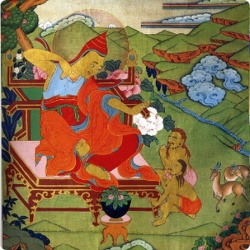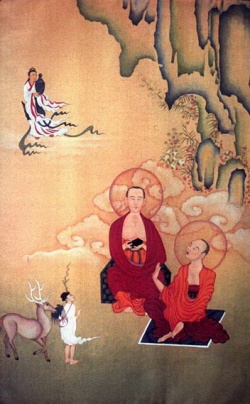Dharmakirti
Dharmakirti (Skt. Dharmakīrti; Tib. ཆོས་ཀྱི་གྲགས་པ་, Chökyi Drakpa; Wyl. [[chos
kyi grags pa]]) (7th Century) was born to a bramhin family in the South of India. After receiving a bramhanical education, he later became interested in the Buddhist teachings.
He then travelled to Nalanda in order to receive teachings from a direct disciple of Vasubandhu. Dharmapāla was still living—Dharmakirti received ordination from him—but Dignaga had passed away. Instead he received instruction from Ishvarasena, who was Dignaga's direct disciple.
Having entirely comprehended Dignaga's oeuvre, he became perhaps the greatest master of pramana and went on to compose the 'Seven Treatises on Valid Cognition'. Dharmakirti (7th century, Facheng) : One of the “six jewels of India” and famed logician. Wrote Commentary on Valid Perception. Student of Ishvarasena, a student of Dignaga.
Writings
- The Seven Treatises on Valid Cognition of which
- Pramanavarttika is the main.
Quotations
དྲི་མ་རྣམས་ནི་གློ་བུར་བ། །
The nature of mind is clear light,
Defilements are only adventitious.
བདག་གཞན་ཆ་ལས་འཛིན་དང་སྡང་། །
འདི་དག་དང་ནི་ཡོངས་འབྲེལ་ལས། །
When there is an “I”, there is a perception of other,
And from the ideas of self and other come attachment and aversion,
As a result of getting wrapped up in these,
All possible faults come into being.
དེ་འདིར་དོན་དམ་ཡོད་པ་ཡིན། །
That which can ultimately perform a function
Is here said to be ultimately existent.
All else besides has relative existence.
Further Reading
- Georges B. J. Dreyfus, Recognizing Reality: Dharmakīrti's Philosophy and Its Tibetan Interpretations, SUNY, 1997
- John D. Dunne, Foundations of Dharmakirti's Philosophy, Wisdom Publications, 2004
- Tom J. F. Tillemans, Scripture, logic, language: essays on Dharmakīrti and his Tibetan successors, Wisdom Publications, 1999
Source
Dharmakīrti (ca. 7th century), was an Indian scholar and one of the Buddhist founders of Indian philosophical logic. He was one of the primary theorists of Buddhist atomism, according to which the only items considered to exist are momentary states of Consciousness.
History
Born around the turn of the 7th century, Dharmakirti was a South Indian Brahmin and became a teacher at the famed Nalanda University, as well as a poet. He built on and reinterpreted the work of Dignaga, the pioneer of Buddhist logic, and was very influential among Brahman logicians as well as Buddhists. His theories became normative in Tibet and are studied to this day as a part of the basic monastic curriculum.
Collins colourfully contextualized Dharmakirti and his experience of disaffection and collegiate misunderstanding at Nalanda:-
Dharmakirti's synthesis is the apex of Buddhist Philosophy, at the moment when it was institutionally fading. Nalanda was still bustling, buoyed by cosmopolitan incursions of Brahmans and lay students, but the weeds were growing around the deserted Stupas not just in the south but in northern India as well.
Dharmakirti is the last flaming of the torch before it blows out, the owl of Minerva taking wing at dusk: the creativity of synthesis as a fading institutional base goes on the defensive. Dharmakirti himself was a lay Buddhist, not a devout Monk, and his personal tone sounds like secular ambition rather than a quest for salvation.
The closing stanza of his great work laments the dearth of capable intellectuals to follow his philosophy: "My work will find no one in this World who would easily grasp its deep sayings. It will be absorbed and perish in my own person, just as a river in the ocean."
A Tibetan historian says that when he finished the work, his pupils showed no Appreciation, and his enemies "tied up the leaves [of the palm-leaf manuscript] to the tail of a dog and let him run through the streets where the leaves became scattered" (Stcherbatsky, 1962: 1:35-36).
In fact, Dharmakirti did end up dominating the leading philosophers of the last generations of Indian Buddhism. But his pessimism was prescient. Leaving Nalanda, he retired to his home in the south, where he founded a Monastery. The next successful Brahman student from the south was to be Shankara, and when he came north, it would be to plunder the carcass of a dying (Indian) Buddhism.
Writings
The Seven Treatises on Valid Cognition:
- Saṃbandhaparikṣhāvrtti (Analysis of Relations)
- Pramāṇaviniścaya (Ascertainment of Valid Cognition)
- Pramāṇavārttikakārika (Commentary on Dignaga's 'Compendium of Valid Cognition')
- Nyāyabinduprakaraṇa (Drop of Reasoning)
- Hetubindunāmaprakaraṇa (Drop of Reasons)
- Saṃtānāntarasiddhināmaprakaraṇa (Proof of Others' Continuums)
- Vādanyāyanāmaprakaraṇa (Reasoning for Debate)
Philosophy
Dharmakirti presents most of his ideas in the guise of commentary on Dignaga's works, even if his theories go beyond what was presented by his predecessor. Some of his ideas, like his proof for the authority of The Buddha's words, are innovations, for Dignaga considered Language just as fallible as inference.
There has long been disagreement among Indian and Tibetan doxographers as to how to categorize Dharmakirti's Thought.
The Gelug school asserts that he expressed Yogachara views, most non-Gelug Tibetan commentators assert that he expressed Sautrantika views and, according to one Tibetan source, a number of renowned later Indian Madhyamikas asserted that he expressed Madhyamaka views.
Stcherbatsky relates Dharmakirti to his own understanding of Kant. He compares Dharmakirti’s ‘point-instant’ to Kant’s thing in itself.
- “ The fundamental difference between the Kantian Thing-in-Itself and Dharmakirti’s ‘Own essence’ consists in the clear identification of the latter with a single point instant of reality which corresponds to a moment of sensation”. ”
Mindstream: the play of beginninglessness and temporality, a continuum
Dharmakīrti (fl. 7th century) wrote a treatise on the nature of the Mindstream in his Substantiation of Other Mindstreams (Saṃtãnãntarasiddhi).
Ratnakīrti (fl. c7-8th century), a Disciple of Dharmakīrti, wrote a work that further developed and refined the themes therein, entitled: 'Refutation of Other mindstreams' (Saṃtãnãntaradusana).
He did not refute the tenets of the Saṃtãnãntarasiddhi but further developed the topic from an empirical one, that is, where there are manifold minds cognized by one's experience of others' Mental processes attributed through the perceived actions of other Sentient beings to an absolutist view, where there is only "one Mindstream" (ekacitta). Ratnakīrti's argument is that the valid cognition (pramāna) of another's Mindstream is an inference (anumāna), not a direct Perception (pratyakṣa).
Moreover, Ratnakīrti introduced the two truths Doctrine as key to the nature of the discussion as inference is trafficking with illusory universals (samanya), the proof of the mindstreams of others, whilst empirically valid in relative Truth (saṃvṛtisatya), does not hold ultimate metaphysical certainty in absolute Truth (paramārthasatya).
Dharmakirti held the Mindstream to be beginningless yet also described the Mindstream as a temporal sequence, and that as there are no true beginnings, there are no true endings, hence, the "beginningless time" motif that is frequently used to describe the concept of Mindstream, as Dunne relates:
- Buddhist philosophers often speak of beginninglessness. It is claimed that the minds of living beings, for example, have no beginning, and that our current Universe is only one in a beginningless cycle of expansion and decay. Some Buddhist thinkers would claim that even the most mundane task can have no true beginning.
That is, if a beginning occurs, there must be some moment, some "now", in which it occurs. For the present to exist, however, there must be a past and a future, for what would "now" mean if there were no time other than now? And of course, if there is a past, then how could now be a beginning? Now should instead be the end of the past. Each beginning in short, must itself have a beginning.
Source
- The general run of mankind is addicted to platitudes and has no Interest in subtlety. Not caring for profound sayings, they are filled with hatred and the filth of envy. So I do not write for them, for my Heart has found satisfaction in my work and through it my Love for deep continuous Meditation over every well-spoken word has been fulfilled.
- None in this World will easily grasp the deep utterances in this work. It will be absorbed by and perish in myself just as a river is absorbed and lost in the ocean. Even those endowed with a tremendous Power of reason cannot fathom the depths. Even those with exceptional intrepidity of Thought cannot perceive its highest Truth.
Eighth century India witnessed the final efflorescence of Buddhist Insight and creativity on the subcontinent.
Although Nalanda continued as the pre-eminent Indian Buddhist centre for another four centuries, before being destroyed in the Muslim invasions, it became increasingly isolated. India turned to its multivalent Hindu roots, whereby devotional and theistic modes won over the populace and Vedanta attracted philosophical thinkers.
Nalanda along with lesser Buddhist schools became scholastic and defensive, and by the time of Dharmakirti an amorphous but pervasive pessimism had begun seriously to affect Indian Buddhists.
At the same time, the message of Buddha began to penetrate Tibet and flowed along the ocean trade routes to South Asia.
It had already entered China, where a host of translators laboured to render Mahayana Sutras and philosophical writings into Chinese, and the first translations into Tibetan were attempted. By the time the Buddhist tradition was virtually forgotten in India, the works of Nagarjuna, Asanga, Vasubandhu, Dignaga, Chandrakirti, Shantideva and Dharmakirti had become foundation stones of a Buddhist renaissance and expansion in strange and alien lands, where it has remained vital until the present.
Dharmakirti was born into a Brahmin family in Trimalaya (perhaps Tirumalla) and from early childhood was recognized as a boy of exceptional intellect. He studied the arts and sciences, was deeply immersed in the Vedas, and by the age of sixteen was accepted as a mature scholar.
Then, when he took up some Buddhist texts and studied them thoroughly, to the surprise and distress of the orthodox community he decided to don the yellow robe. After resisting the persuasive arguments of local Hindu scholars, he was forced to leave his home.
Making his way to Nalanda, he was brought into The Sangha by Dharmapala and formally made a pupil of Vasubandhu, who was, however, too old to undertake the strain of conducting Dharmakirti's Spiritual education. Eventually he came under the guidance of Ishvarasena, a pupil of Dignaga, who saw to his training and read him Dignaga's works on logic and dialectic. On his first reading of Dignaga's famous Pramanasamuccaya, Dharmakirti understood it. On his second reading he assessed its inadequacies, and on his third he boldly proclaimed his critique.
Many would have held this to be irreverent, but Ishvarasena was delighted and instructed Dharmakirti to compose a commentary on his mentor's great work. After deep Meditation he had a vision of Heruka, the fierce protective emanation of The Buddha Akshobhya, who blessed him with three mystic sounds. Then Dharmakirti began to write, producing the greatest works in the history of Buddhist logic.
Owing to his vast Knowledge of non-Buddhist doctrines, he willingly restricted his debating activities to tirthikas. Though his dialectical skills and impeccable fairness were deeply appreciated at Nalanda, his writings were received with indifference because none could fully understand them. Eventually he travelled to debate in courts and scholarly centres throughout the land. When he came to Kalinga, he built a Monastery and remained there, teaching a large group of disciples until he died.
Gradually his greatness as a thinker became clear to the Spiritual descendants of his own disciples. In time he was seen as perhaps the only Buddhist dialectician who equalled even Shankaracharya, and an apocryphal legend arose that he had actually vanquished the Philosopher in debate.
It is possible, given scanty evidence, that he debated and converted the son of Bhatta Acharya, who was believed to be a Reincarnation of Shankara. According to Taranatha, after Dharmakirti died, a shower of Flowers fell during the Cremation ceremony and sweet celestial music was heard for seven days thereafter. His bones spontaneously formed into a crystal orb, which was preserved at Kalinga for many years.
Dharmakirti composed seven works which came to be known as the "Seven Treatises", the quintessential survey of logic for Tibetan Buddhists. His philosophical neutrality made his views compatible with a variety of doctrines, and they were readily inserted into the teachings of Chandrakirti and Shantideva. Dharmakirti's self-engendered Conversion convinced him that Buddha is the ultimate source of all Knowledge, leading him to try to unravel the inner logic of the Teachings.
His methodological scepticism compelled him to reject the authority of Buddhist scriptures except when they withstood the same rigorous dialectical examination to which he subjected non-Buddhist texts. Though he accepted Dignaga's view that Perception is a Form of Knowledge, he added that it had to be unerring. For him, the transience of the external World did not mean that it was simply unreal, but rather that one had to understand the nature of its reality.
Perception is of fleeting moments, instants in time and space, and the seeming continuity given to objects of Perception is produced by the Mind. Pure Perception itself is of reality and is instantaneous, but what is perceived is necessarily Thought of and expressed in terms of cognitive relationships, which are an Illusion. Only inference can deal with universals, and thus the objects of Perception and inference are quite different from one another.
Logic cannot be wholly separated from epistemology, and so logic leads naturally into a dialectic which, as Nagarjuna taught, inevitably undermines positive beliefs and formulations. Without Meditation and discipline, dialectic tends towards sceptical pessimism, but with them, it provides a purifying way of Life not dependent on false claims to know.
His Pramanavartikakarika is a sweeping commentary on Dignaga's great text, and it is condensed in his Nyayabindu (The Drop of Logic), long preserved in Tibetan but recently recovered in a Sanskrit manuscript found in a Jam temple. In the first chapter Dharmakirti held that all the ends sought by human beings are attained through Knowledge, which must not only be valid but also perfect. Such Knowledge is gained through pratyaksha and anumana, Perception and inference.
Perception, however, must be free from preconception and error. For Dharmakirti, preconception is not merely the crude surcharge of perspectives and conclusions imposed upon what one perceives. These have to be purged before one can even begin to speak of perceiving.
Rather, preconception is in essence the throwing up of false images which are then erroneously Thought to be objects of Perception, as when one mistakes the shadow of a tree for the tree itself or a rope for a snake. Error tends to occur when the context of Perception is not sufficiently taken into account. For instance, one will not see clearly in darkness, or, when one travels downstream on a boat, the trees on the river banks will appear to be moving upstream.
Although examples drawn from sight are the most accessible illustrations of Perception and preconception, Dharmakirti insisted that Perception through the five senses is only one kind of Perception, and not the most important. There is also Perception by the Mind, encompassing the objects of Dreams and contemplation. Perhaps the most readily recognized but most difficult to describe mode of Perception is that of self-Consciousness.
Finally there is the noetic Perception of the accomplished meditator. It is incommunicable to one who has no commensurate experience save by analogy and correspondence, for it reflects the perceptive mysteries. Perception differs from inference, for the object of inference is like any other object in its class (samanyalakshana), whilst the object of Perception is only like itself (svalakshana).
A cow which is seen is unique and cannot be replaced by another cow without altering the Perception. The cow that is inferred, however, belongs to a class, and any member of that class can be substituted by any other. Perceptual Knowledge is, therefore, of particulars and inferential Knowledge is general. Objects of Perception consist of instantaneous moments given seeming duration through an act of the Mind which blurs perceptions together.
Similarly, the false sense of self is formed by assuming continuity on the basis of a contiguity of moments. When objects of Perception are stripped of these superadded Mental accretions, so that they remain purely svalakshana, they are paramarthasat, absolutely real.
From this standpoint the highest Enlightenment is pure Perception. Negative Perception, perceiving that something is not, has some epistemological relevance but played no logical role in Dharmakirti's system. Enlightenment involves Shunyata, the Void, but it is in no sense negative Perception.
Dharmakirti, like Dignaga, distinguished between inference for oneself (svarthanumana) and inference for the sake of others (pararthanumana), for though both involve the middle term or reason, inference for others requires that the reason be stated in convincing words. Inference for oneself involves a kind of syllogism in which the reason must meet three requirements. In the example
the middle term ('smoke') must abide in the minor term ('hill'), that is, there must indeed be smoke on the hill. Secondly, the middle term ('smoke') has to abide only in cases which are homologous with the major term ('Fire'). Thus, smoke is in a kitchen, and a kitchen is homologous with things that contain Fire. Thirdly, the middle term ('smoke') must never abide in cases which are heterologous with the major term ('Fire'). Smoke never occurs in a lake, which is heterologous with things that contain Fire.
Besides having to meet these three conditions, the middle term has to be one of three kinds.
It could bear a relation of identity to the major term, including what modern logic would call being a subset, as in the statement "This is a tree, because it is a shimshapa", since the shimshapa is a kind of tree. The minor term could be an effect, as in "There is Fire, because there is smoke", since smoke is an effect of Fire. Dharmakirti added a broad class of relationships all called non-Perception, such as non-Perception of identity ("There is no smoke here, because it is not seen"), or of effect and of container ("There is no shimshapa here, because there is no tree here whatsoever").
Under non-Perception he included Perception contrary to identity ("There is no cold here, because there is Fire"), Perception of opposite effect, Perception of contrary connection between cause and effect (including multiple causation), Perception contrary to the effect, and Perception contrary to the container. Finally he distinguished non-Perception of the cause, Perception contrary to the cause, and Perception of an effect contrary to the cause, to complete a list of eleven forms of non-Perception.
Inference for the sake of others requires putting the argument in words acceptable to all concerned, for though words themselves are not Knowledge, they can educe it when rightly used. All inference is either affirmation or denial, linking terms in ways which produce statements or theses. A thesis is false if it is incompatible with Perception, inference, conception or one's previous statements.
Fallacies of the middle term occur when any of the requirements it must meet are unproven, uncertain or contradictory. For example, "Sound is eternal, because it is visible" is rejected as unproved, since no one will grant the visibility of Sound. "Trees are conscious, because they die if their bark is removed" is unproved if the opponent points to types of trees that survive the removal of bark.
The argument "Sound is non-eternal, because it is knowable" is uncertain, for the category of the knowable includes eternal as well as non-eternal members. And the thesis "Sound is eternal, because it is a product" must be rejected because 'product' is not homogeneous with 'eternal', that is, the middle and major terms are contradictory.
In inference for the sake of others, examples already familiar to the listener are offered to illustrate and support the inference drawn. In the argument that there is Fire on the hill, the examples were 'like a kitchen' and 'unlike a lake'. The first is homogeneous, being the same as the hill, for both have smoke. The second is heterogeneous, because, unlike a kitchen, it does not have smoke.
Homogeneous examples can be fallacious, that is, render the 'syllogism' untenable, when they fail to support the thesis. For instance, in the argument "Sound is eternal, because it is incorporeal, like action", action is not a viable example, since it is not eternal and is therefore excluded from the minor term.
In "This man is not omniscient, because he is passionate, like the person in the street", the example fails because it is moot whether the person in the street is passionate and also questionable whether he is or is not omniscient. In Dharmakirti's strict system, refutation (dushana) consists in pointing out any of these fallacies. Refutation does not necessarily prove that a thesis is wrong, but only that it is unsupported or unclear.
Unlike Dignaga, Dharmakirti did not recognize any difference between a contradiction, in which two terms are opposed, and an implied contradiction, in which the terms are opposed if one of them is taken in a certain sense.
For Dharmakirti, each term in an argument must be restricted to one meaning. Hence, if a contradiction appears, it will invariably be of the first kind. Since words may carry multiple denotations, the context determines the single relevant meaning. Whilst such an approach cannot exhaust the richness and resonance of scripture, Dharmakirti held that Sacred Texts are not patently transparent.
Their meanings are matters of progressive contemplation which must be tested and clarified through inference for oneself. Ultimately, the meaning of the Teachings will be fully understood through the highest Perception. Logic is an aid, but it deals with exposition, both to oneself and to others, and not directly with pure Insight. Insight will be clouded, however, if the dialectical basis for Knowledge by inference is unsound.
These concerns led Dharmakirti to reject Dignaga's non-erroneous contradiction as a fallacy of uncertainty. It arises when opposing conclusions are drawn from syllogisms acceptable to differing schools of Thought. For Dharmakirti, the opposition arises from differing, and perhaps hidden, assumptions and has nothing to do with inference. Mere appeal to scripture as authority is useless, for it implies that one's understanding of scripture is perfect and therefore authoritative.
Despite his rigorous focus on logic and dialectic, Dharmakirti saw these as tools to aid oneself and others along the Bodhisattva Path and not as ends in themselves. He expressed disappointment that his work was unappreciated, not because it was challenged – for it was not – but because so few seemed to understand it or recognize its value.
Whilst Dharmakirti did not live to see his work widely respected, generations of Buddhists after his Death did take it up. Due to the decline of Buddhist tradition in India, however, it was left to Hindu thinkers to advance Indian concerns with logic and dialectic. Dharmakirti would eventually be forgotten in his homeland, though his Thought was reflected in subsequent Hindu logical treatises, but he was revered in Tibet, China and southeastern Asia.
Although the Buddhist tradition survived in India until the thirteenth century, Dharmakirti knew that he stood at the beginning of the final illustrious chapter in the story. More important for the future, he also stood at the beginning of the magnificent unfolding of the Tibetan tradition, a story entering a dramatic new phase in the late twentieth century.
See; Pramana and Kadampa Lineage

